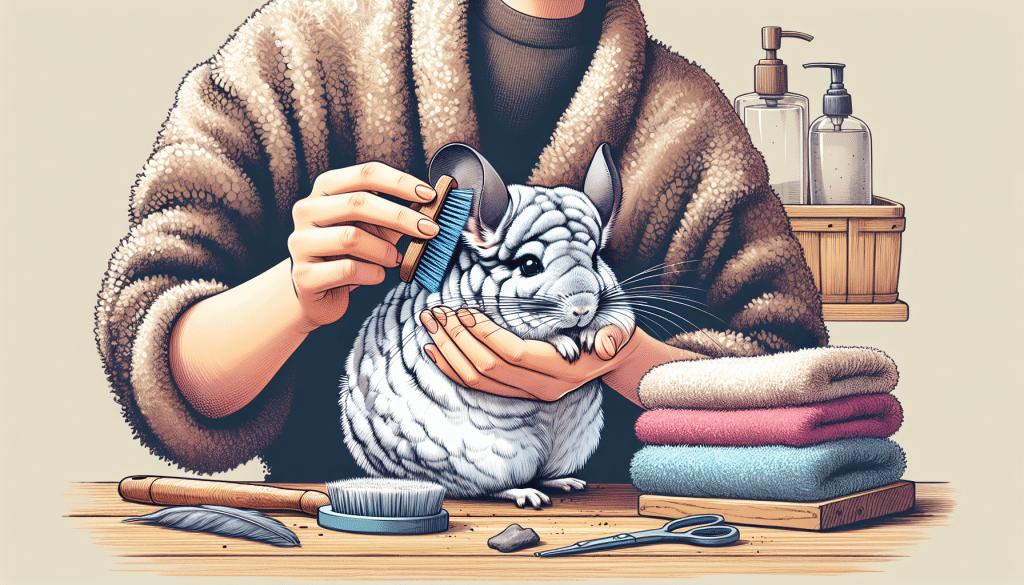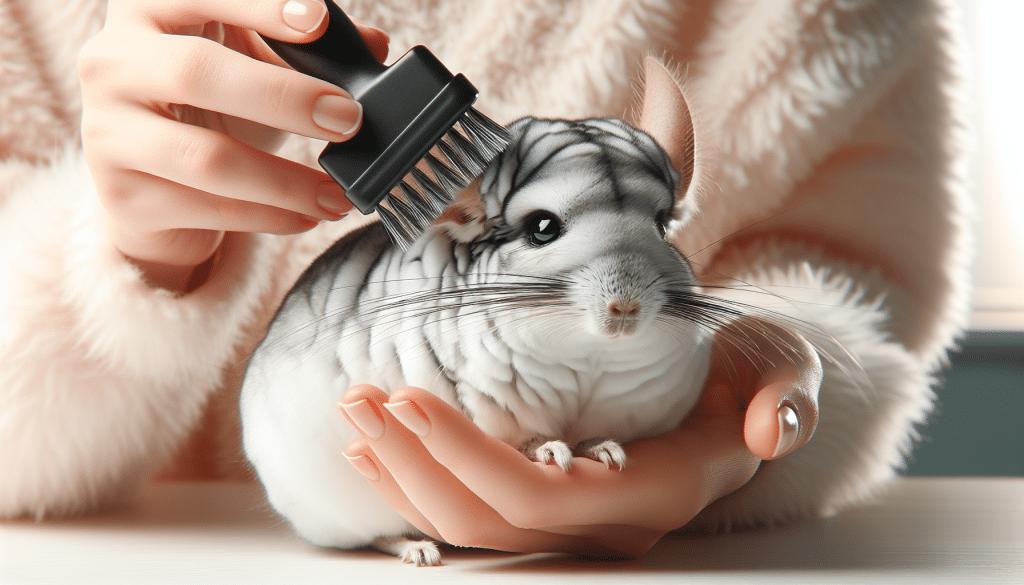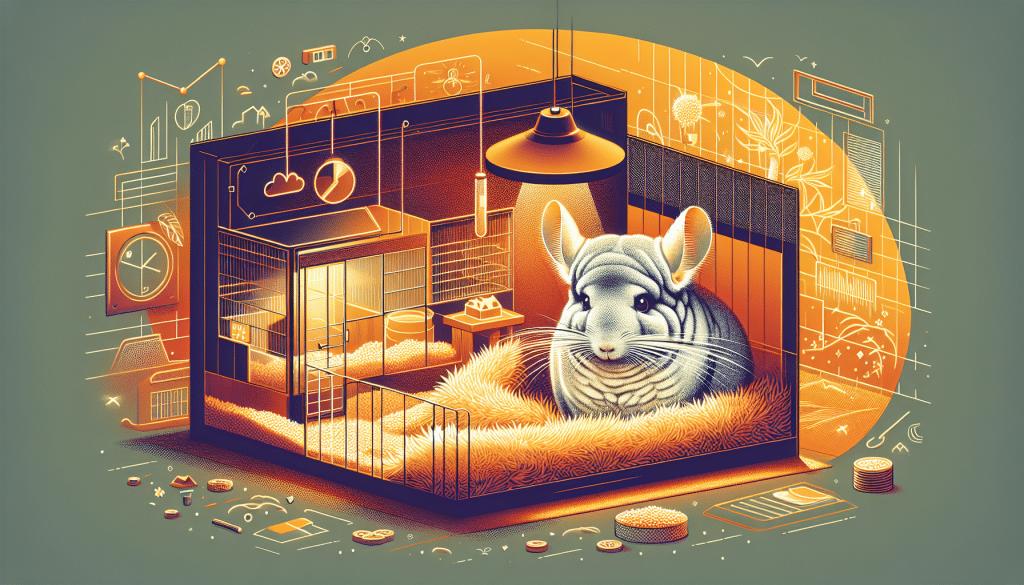So, you’ve decided to bring a cute little chinchilla into your home, but now you’re wondering how to properly groom your new furry friend. Well, fret no more! In this article, you’ll discover all the essential tips and tricks for maintaining your chinchilla’s well-being and ensuring they stay happy and healthy. From brushing their fur to trimming their nails, we’ve got you covered on everything you need to know about chinchilla grooming. So, get ready to pamper your delightful chin with our expert advice!

Understanding Chinchilla Grooming Needs
Chinchillas have unique fur characteristics that require regular grooming to maintain their health and well-being. Understanding their grooming needs is essential in ensuring their fur remains clean and tangle-free.
Unique Fur Characteristics
Chinchillas have incredibly dense fur that helps provide insulation in their natural habitat in the Andes Mountains. This dense fur also makes them prone to overheating, so proper grooming is essential to prevent heat-related issues. Additionally, chinchillas have fur that is incredibly soft and delicate, making it susceptible to matting and tangles if not properly cared for.
Self-Cleaning Capabilities
Chinchillas are known for their remarkable self-cleaning abilities. They groom themselves by taking dust baths, rolling around in specialized dust that absorbs excess oils and dirt from their fur. This natural behavior helps keep their fur clean and prevents matting. While chinchillas are capable of self-grooming, they still require human assistance to maintain optimal fur and skin health.
Frequency of Required Grooming
Chinchillas should ideally be groomed at least once a week to prevent matting and maintain good overall hygiene. However, individual chinchillas may require more frequent grooming based on their fur length, activity level, and overall health. It’s important to monitor your chinchilla’s fur condition regularly and adjust your grooming schedule accordingly.
Setting Up a Grooming Environment
Creating a suitable grooming environment for your chinchilla is crucial to ensure their comfort and safety during grooming sessions.
Choosing the Right Location
Find a quiet and well-lit area in your home where you can set up a small grooming station for your chinchilla. It should be a space free from distractions and potential hazards. A tabletop or a dedicated grooming table can work well for the task.
Maintaining the Right Temperature
Chinchillas are sensitive to heat, so it’s important to groom them in an area with a controlled temperature. Avoid grooming near heating vents or in rooms that may become too warm. Ideally, the grooming area should be well-ventilated and kept at a temperature between 60 to 70 degrees Fahrenheit.
Minimizing Stress During Grooming
Chinchillas are sensitive creatures, and grooming sessions can be stressful for them. To minimize anxiety, always approach grooming with a calm and gentle demeanor. Use soft and soothing tones when speaking to your chinchilla, and avoid sudden movements that may startle them. Offer treats and positive reinforcement to create a positive association with grooming.

Dust Baths: The Cornerstone of Chinchilla Grooming
Dust baths are an essential part of a chinchilla’s grooming routine and play a significant role in maintaining their fur’s health and cleanliness.
Proper Dust Bathing Material
Chinchillas require a specialized dust bath material that is specifically made for their grooming needs. Avoid using regular sand or soil, as they can be harmful to their respiratory system. Opt for chinchilla-safe dust, which is available at pet stores or online.
How to Give a Dust Bath
To provide your chinchilla with a dust bath, fill a shallow container (such as a dust bath house or a small dish) with a thin layer of chinchilla dust. Place the container in the grooming area and allow your chinchilla to enter and roll around in the dust. Let them enjoy the bath for about 10 to 15 minutes before removing the container.
Dust Bath Frequency
Chinchillas should have access to a dust bath at least two to three times a week. Regular dust baths help remove excess oils, dirt, and debris from their fur, preventing matting and other skin issues. However, be mindful not to overdo it, as excessive dust bathing can lead to dryness and irritation.
Cleaning the Dust Bath Container
After each use, discard the soiled dust and clean the container thoroughly. It’s important to remove any moisture or debris from the container to prevent the growth of bacteria or fungi. Regularly sanitize the dust bath container to maintain good hygiene.
Brushing Your Chinchilla
Brushing your chinchilla’s fur is an important part of grooming that helps prevent matting and keeps their coat in top condition.
Choosing the Right Brush
Selecting a suitable brush is crucial to avoid causing discomfort or injury to your chinchilla. Look for a brush specifically designed for small animals with soft bristles. Avoid brushes with sharp or stiff bristles, as they can damage the delicate chinchilla fur.
Technique for Brushing
Begin brushing your chinchilla by gently stroking their fur in the direction of hair growth. Be mindful not to pull or tug on any tangles or mats. If you encounter any knots, use your fingers or a soft comb to carefully work through them. Take your time and ensure your chinchilla is comfortable throughout the process.
Avoiding Mats and Tangles
Regular brushing sessions will help prevent mats and tangles from forming in your chinchilla’s fur. Pay special attention to areas prone to matting, such as under the chin, around the ears, and along the back. By brushing consistently and keeping their fur clean, you can avoid painful and potentially harmful matting.

Monitoring Skin and Fur Health
Regularly inspecting your chinchilla’s skin and fur is essential in detecting any signs of parasites, irritations, or infections.
Looking for Signs of Parasites
With a close examination, check for any small black specks resembling pepper flakes, as these could be signs of fleas or mites. Pay attention to areas with thin fur, such as the belly, armpits, and tail, as parasites tend to gather in these spots. If you suspect an infestation, consult with a veterinarian for appropriate treatment.
Identifying Skin Irritations or Infections
Inspect your chinchilla’s skin for any redness, swelling, sores, or scabs. These may indicate skin irritations or infections, such as dermatitis or fungal infections. If you notice any abnormalities, seek veterinary care promptly to prevent the issue from worsening.
When to Seek Veterinary Care
If you notice any significant changes in your chinchilla’s skin or fur health, such as persistent itching, hair loss, or an unusual odor, it’s important to consult a veterinarian. They will be able to diagnose and treat any underlying issues effectively.
Nail Trimming Essentials
Keeping your chinchilla’s nails properly trimmed is essential for their comfort and to prevent overgrowth or injury.
Choosing Appropriate Nail Clippers
Selecting the right type of nail clippers is crucial to ensure safe and effective trimming. Small, pet-specific nail clippers or guillotine-style clippers work well for chinchilla nails. Avoid using human nail clippers, as they may cause discomfort or accidents.
Technique for Safe Nail Trimming
Gently hold your chinchilla’s paw, ensuring a firm but gentle grip. Carefully trim the tip of each nail, being cautious not to cut into the quick. The quick is the pink part of the nail that contains blood vessels and nerves, and cutting into it can be painful and cause bleeding. If you are unsure about the proper technique, seek guidance from a veterinarian or an experienced chinchilla owner.
Avoiding the Quick
To minimize the risk of cutting into the quick, trim only the curved part of the nail. If your chinchilla has dark nails, shine a light through them to help visualize the quick. Trim in small increments and observe the nail’s cross-section to determine proximity to the quick. Take breaks between nails to reduce stress for both you and your chinchilla.
Ear and Eye Care for Chinchillas
Caring for your chinchilla’s ears and eyes is an important aspect of their grooming routine.
Cleaning Your Chinchilla’s Ears
Chinchillas generally do not require extensive ear cleaning, as they have mechanisms in place to keep their ears relatively clean. However, you should inspect the ears regularly for any signs of discharge, redness, or swelling. If you notice any abnormalities, consult your veterinarian for further guidance.
Eye Health Checkups
Regularly check your chinchilla’s eyes for any signs of discharge, cloudiness, or redness. Chinchillas are prone to eye infections, and early detection is crucial for effective treatment. If you notice any persistent issues or changes in your chinchilla’s eye health, consult a veterinarian.
Handling Discharge or Tear Stains
Occasionally, chinchillas may develop tear stains or crusty discharge around their eyes or nose. Gently wipe away any discharge or stains with a soft, damp cloth. Avoid using harsh chemicals or substances near the eye area, as they may irritate the sensitive tissues. If tear stains persist or worsen, consult a veterinarian for further evaluation.
Dealing with Fur Chewing
Chinchillas may engage in fur chewing behavior, which can lead to bald patches or skin irritations if not addressed.
Understanding Why Chinchillas Chew Fur
Fur chewing in chinchillas can be triggered by various factors, including boredom, stress, or a need for additional fiber in their diet. Common culprits of fur chewing include inadequate environmental enrichment, lack of mental or physical stimulation, or an unbalanced diet.
Modifying Behavior Through Enrichment
To discourage fur chewing, it’s essential to provide your chinchilla with a stimulating and enriching environment. Offer a variety of safe chew toys, such as wooden blocks or branches, to redirect their chewing behavior. Rotate toys regularly to keep them interesting and engage with your chinchilla through playtime and social interaction.
Addressing Potential Dietary Issues
Ensure your chinchilla’s diet is well-balanced and provides sufficient fiber. Offer a variety of high-quality hay to promote dental health and provide mental stimulation. If you suspect dietary deficiencies may be contributing to fur chewing, consult a veterinarian or a knowledgeable exotic pet nutritionist for dietary recommendations.
Chinchilla Grooming Accessories
Having the right grooming tools and accessories can simplify and enhance your chinchilla’s grooming routine.
Essential Grooming Tools
The essential grooming tools for chinchillas include a suitable brush, chinchilla-safe dust for dust baths, and pet-specific nail clippers. Investing in high-quality tools will ensure effective grooming and minimize the risk of injury or discomfort.
Optional Accessories for Enhanced Care
In addition to the essentials, there are optional accessories that can enhance your chinchilla’s grooming experience. These may include grooming gloves or mitts for gentle fur cleaning, pet-safe wipes for spot cleaning, and specialized ear or eye cleaning solutions. Choose accessories that are specifically formulated for chinchilla use to ensure their safety and effectiveness.
Sourcing Quality Grooming Supplies
When selecting grooming supplies for your chinchilla, choose reputable brands that prioritize the safety and well-being of small animals. Look for products that are specifically formulated for chinchillas and have positive reviews from other chinchilla owners. Consult with your veterinarian or fellow chinchilla enthusiasts for recommendations on trustworthy brands and suppliers.
Troubleshooting Common Grooming Challenges
Despite your best efforts, you may encounter some challenges during the grooming process. Here are some tips for overcoming common grooming obstacles with chinchillas.
Dealing with Uncooperative Chinchillas
Some chinchillas may resist or become anxious during grooming sessions. If your chinchilla is uncooperative, take a break and resume grooming at a later time when they are calmer. Use positive reinforcement, such as treats or verbal praise, to encourage cooperation. Build a trusting relationship with your chinchilla through consistent and gentle handling.
Overcoming Difficulties with Nail Clipping
Nail trimming can be challenging, especially if your chinchilla is not accustomed to the process. Gradually introduce them to nail clipping by first familiarizing them with the nail clippers and offering treats to create positive associations. If they remain resistant, consider seeking professional help from a veterinarian or a qualified groomer to ensure safe and effective nail trimming.
Mitigating Dust Bath Messes
Dust baths can create a bit of a mess, with dust particles potentially spreading around the grooming area. To minimize dust-related issues, place the dust bath container in a larger container or enclosed space to contain the dust. Consider covering the surrounding surfaces with a washable mat or towel for easy cleanup. Regularly vacuum or sweep the area to prevent dust accumulation.
By understanding and meeting your chinchilla’s grooming needs, you can help them maintain a healthy and comfortable coat. Remember to approach grooming with patience, gentleness, and a positive attitude. Regular grooming sessions not only contribute to your chinchilla’s well-being but also provide an opportunity for bonding and strengthening your relationship.

